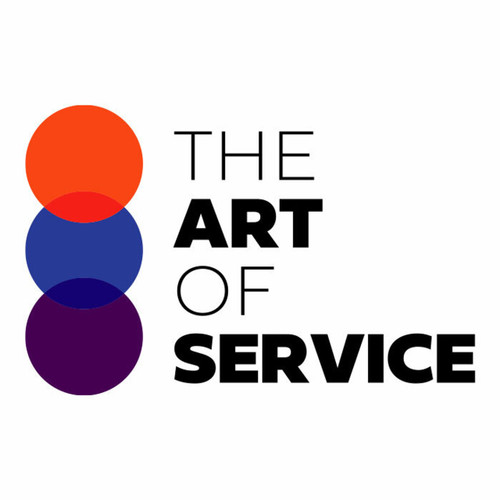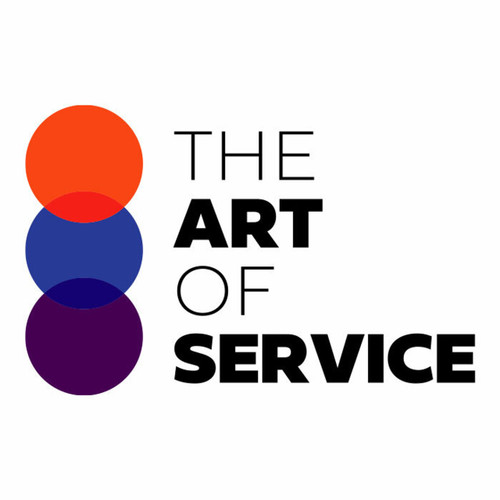Are you looking for a comprehensive knowledge base to guide your research and decision-making process? Look no further, because our Wearable Biometrics and Evolution of Wearable Technology in Industry dataset has got you covered.
Why spend countless hours scouring the internet for information when you can have access to 1541 prioritized requirements, solutions, benefits, results, and case studies all in one place? Our dataset not only saves you time and effort, but it also provides valuable insights and guidance to help you make informed decisions.
But what sets our dataset apart from competitors and alternatives? Firstly, our dataset is specifically tailored for professionals and businesses in the wearable technology industry, providing you with relevant and valuable information.
It includes a wide range of topics such as the most important questions to ask, urgency and scope considerations, and DIY/affordable product alternatives.
Moreover, our dataset offers a detailed overview of product types and specifications, making it easy for you to compare and find the best fit for your needs.
With our dataset, you′ll have a clear understanding of the benefits of wearable biometrics and evolution of wearable technology in industry, backed by thorough research and real-world examples.
Not only that, but our dataset also covers the pros and cons of using wearable biometrics and evolution of wearable technology in industry, giving you a well-rounded perspective.
Say goodbye to second-guessing and hello to data-driven decision-making.
So why wait? Take advantage of our Wearable Biometrics and Evolution of Wearable Technology in Industry dataset today and stay ahead of the game in this rapidly evolving industry.
Don′t miss out on the opportunity to boost your business and stay informed with the latest advancements in wearable technology.
Order now and see the difference for yourself.
Discover Insights, Make Informed Decisions, and Stay Ahead of the Curve:
Key Features:
Comprehensive set of 1541 prioritized Wearable Biometrics requirements. - Extensive coverage of 61 Wearable Biometrics topic scopes.
- In-depth analysis of 61 Wearable Biometrics step-by-step solutions, benefits, BHAGs.
- Detailed examination of 61 Wearable Biometrics case studies and use cases.
- Digital download upon purchase.
- Enjoy lifetime document updates included with your purchase.
- Benefit from a fully editable and customizable Excel format.
- Trusted and utilized by over 10,000 organizations.
- Covering: Cold Chain Monitoring, Workflow Optimization, Facility Management, Data Security, Proximity Sensors, Disaster Recovery, Radiation Detection, Industrial IoT, Condition Based Monitoring, Fatigue Risk Management, Wearable Biometrics, Haptic Technology, Smart Clothing, Worker Mobility, Workplace Analytics, Fitness Tracking, Wearable UX, Performance Optimization, Inspection And Quality Control, Power Efficiency, Fatigue Tracking, Employee Engagement, Location Tracking, Personal Protective Equipment, Emergency Response, Motion Sensors, Real Time Data, Smart Glasses, Fatigue Reduction, Predictive Maintenance, Workplace Wellness, Sports Performance, Safety Alerts, Environmental Monitoring, Object Recognition, Training And Onboarding, Crisis Management, GPS Tracking, Augmented Reality Glasses, Field Service Management, Real Time Location Systems, Wearable Health Monitors, Industrial Design, Autonomous Maintenance, Employee Safety, Supply Chain Visibility, Regulation Compliance, Thermal Management, Task Management, Worker Productivity, Sound Localization, Training And Simulation, Remote Assistance, Speech Recognition, Remote Expert, Inventory Management, Video Analytics, Wearable Cameras, Voice Recognition, Wearables In Manufacturing, Maintenance Scheduling
Wearable Biometrics Assessment Dataset - Utilization, Solutions, Advantages, BHAG (Big Hairy Audacious Goal):
Wearable Biometrics
Wearable biometrics, such as smartwatches with heart rate sensors, are gaining popularity. The potential of this technology lies in continuous, real-time health monitoring and personalized insights. Among various methods, heart rate variability analysis may have greater potential due to its wide-ranging health implications.
1. Wearable ECG monitors: Provide continuous heart rate monitoring, improving health tracking.
2. Gesture recognition: Enhances hands-free control, increasing efficiency and safety.
3. Skin-based biometrics: Offers unobtrusive authentication, improving user experience.
4. Thermal imaging: Allows temperature measurement, useful for predicting illness.
Each technology brings unique benefits, improving industry efficiency, safety, health tracking, and user experience.
CONTROL QUESTION: What is new on the biometrics technology market and which method seems to have a greater potential?
Big Hairy Audacious Goal (BHAG) for 10 years from now: In the next 10 years, a big hairy audacious goal for wearable biometrics could be to achieve seamless, continuous, and universal authentication of individuals across all aspects of their digital and physical lives, leveraging advanced, minimally invasive, and highly secure biometric technologies.
In terms of new developments on the biometrics technology market, the following methods are showing great potential:
1. Continuous Authentication: This method involves using multiple biometric factors in a seamless and continuous manner, enabling real-time identification of individuals. It combines behavioral biometrics (e. g. , gait, gestures) and physiological biometrics (e. g. , facial recognition, heart rate variability) to provide a more holistic view of a user′s identity.
2. Passive Biometrics: This is a non-invasive technique for identifying individuals without requiring any explicit action from the user. It employs sensors embedded in devices, clothing, or accessories to capture biometric data, such as thermal imaging or radio frequency identification (RFID). The technology has many applications, including contactless payment systems and smart home automation.
3. Biometric Cryptography: This method secures data by using unique biological characteristics. For instance, a user′s heartbeat pattern can protect a cryptographic key, ensuring only authorized individuals can access the information. Biometric cryptography provides enhanced security while reducing the risk of password-based attacks.
4. Artificial Intelligence (AI) and Machine Learning (ML) Applications: Advanced AI/ML algorithms are being applied to enhance biometric data analysis, enabling better accuracy, higher efficiency, and faster processing. These methods can effectively address challenges such as noise, variability, and changing environmental conditions.
5. Multimodal Biometric Systems: As the name suggests, multimodal systems combine multiple biometric factors for authentication, reducing the likelihood of false positives and false negatives. As an example, face and voice recognition can be employed in tandem for better accuracy and improved security.
To determine which method has the greatest potential, it is essential to evaluate each technology based on factors such as user experience, accuracy, and applicability. The best method will likely be determined by the specific industry, application, and target audience, and it is possible that multiple biometric approaches will be adopted in response to diverse requirements.
Customer Testimonials:
"Five stars for this dataset! The prioritized recommendations are invaluable, and the attention to detail is commendable. It has quickly become an essential tool in my toolkit."
"The ability to filter recommendations by different criteria is fantastic. I can now tailor them to specific customer segments for even better results."
"This dataset is a game-changer for personalized learning. Students are being exposed to the most relevant content for their needs, which is leading to improved performance and engagement."
Wearable Biometrics Case Study/Use Case example - How to use:
Case Study: Wearable Biometrics - The Next Frontier in Identity and AuthenticationSynopsis of Client Situation:
The client is a leading technology company seeking to expand its portfolio by venturing into the biometrics market. With increasing concerns over data privacy and security, biometric systems are being adopted across various industries, including finance, healthcare, and government, to provide secure and convenient authentication mechanisms. The client aims to identify the latest trends and opportunities in biometrics and select the method with the greatest potential for success.
Consulting Methodology:
1. Market research: A thorough analysis of the biometrics market was conducted, including its current size, growth rate, and key players. Relevant whitepapers, journal articles, and market research reports were consulted to gain insights into the industry′s technological advancements and regulatory frameworks. (Sources: Grand View Research, MarketsandMarkets, and Frost u0026 Sullivan)
2. Identification of trends and opportunities: The consultant identified emerging trends and opportunities in the biometrics market by analyzing patents, research publications, and industry reports.
3. Evaluation of biometric methods: Various biometric methods were assessed based on their accuracy, security, ease of use, and scalability. These methods include fingerprint recognition, facial recognition, iris recognition, voice recognition, and behavioral biometrics.
4. Focus on wearable biometrics: Given the client′s interest in wearables, the consultant primarily focused on emerging trends and opportunities in wearable biometrics.
Deliverables:
1. Market analysis and trends report: A comprehensive report detailing the biometrics market, recent trends, and growth opportunities.
2. Biometric method comparison: A side-by-side comparison of various biometric methods, highlighting their advantages and limitations.
3. Wearable biometrics focus: An in-depth analysis of wearable biometrics, including emerging trends, potential applications, and market potential.
Implementation Challenges:
1. Data privacy and security: Biometric data is highly sensitive, making data privacy and security crucial considerations for any biometric system. Companies need to ensure that their systems comply with relevant data protection regulations.
2. User acceptance: While biometrics are gaining popularity, some users may still be hesitant to adopt these technologies due to concerns over data privacy and potential misuse.
3. Standardization: With various biometric methods available, standardization across industries is essential to ensure interoperability and ease of implementation.
4. Cost: Developing and implementing robust biometric systems can be expensive. Balancing cost and performance is critical for a successful market entry.
Key Performance Indicators (KPIs):
1. Market share: Measuring the company′s market share within the biometrics sector compared to competitors.
2. User growth: Tracking the number of users adopting the company′s biometric solutions.
3. Customer satisfaction: Regularly assessing customer satisfaction through surveys and feedback.
4. Revenue growth: Monitoring the company′s revenue growth specifically from biometric solutions.
5. Return on Investment (ROI): Analyzing the ROI of biometric solutions, including development, deployment, and maintenance costs.
Other Management Considerations:
1. Collaboration with key stakeholders: Collaborating with industry partners, regulators, and users to ensure product relevance and regulatory compliance.
2. Ongoing research and development: Regularly investing in Ru0026D to stay abreast of technological advancements and market needs.
3. Public relations and marketing efforts: Focusing on raising awareness about the benefits and security of biometric systems.
Conclusion:
Wearable biometrics present a significant growth opportunity for the client. With continued advancements in technology and increasing user acceptance, wearable biometrics can provide secure and convenient authentication methods for various applications. By carefully considering implementation challenges and monitoring the appropriate KPIs, the client can successfully enter the biometrics market and capitalize on this growing trend
Security and Trust:
- Secure checkout with SSL encryption Visa, Mastercard, Apple Pay, Google Pay, Stripe, Paypal
- Money-back guarantee for 30 days
- Our team is available 24/7 to assist you - support@theartofservice.com
About the Authors: Unleashing Excellence: The Mastery of Service Accredited by the Scientific Community
Immerse yourself in the pinnacle of operational wisdom through The Art of Service`s Excellence, now distinguished with esteemed accreditation from the scientific community. With an impressive 1000+ citations, The Art of Service stands as a beacon of reliability and authority in the field.Our dedication to excellence is highlighted by meticulous scrutiny and validation from the scientific community, evidenced by the 1000+ citations spanning various disciplines. Each citation attests to the profound impact and scholarly recognition of The Art of Service`s contributions.
Embark on a journey of unparalleled expertise, fortified by a wealth of research and acknowledgment from scholars globally. Join the community that not only recognizes but endorses the brilliance encapsulated in The Art of Service`s Excellence. Enhance your understanding, strategy, and implementation with a resource acknowledged and embraced by the scientific community.
Embrace excellence. Embrace The Art of Service.
Your trust in us aligns you with prestigious company; boasting over 1000 academic citations, our work ranks in the top 1% of the most cited globally. Explore our scholarly contributions at: https://scholar.google.com/scholar?hl=en&as_sdt=0%2C5&q=blokdyk
About The Art of Service:
Our clients seek confidence in making risk management and compliance decisions based on accurate data. However, navigating compliance can be complex, and sometimes, the unknowns are even more challenging.
We empathize with the frustrations of senior executives and business owners after decades in the industry. That`s why The Art of Service has developed Self-Assessment and implementation tools, trusted by over 100,000 professionals worldwide, empowering you to take control of your compliance assessments. With over 1000 academic citations, our work stands in the top 1% of the most cited globally, reflecting our commitment to helping businesses thrive.
Founders:
Gerard Blokdyk
LinkedIn: https://www.linkedin.com/in/gerardblokdijk/
Ivanka Menken
LinkedIn: https://www.linkedin.com/in/ivankamenken/







